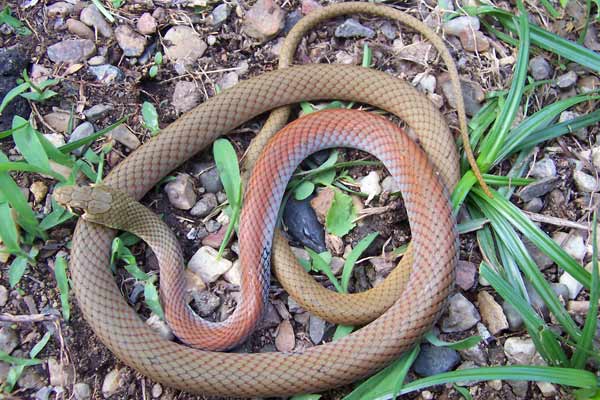Yellow-faced Whip Snake

(Demansia psammophis)
Other common names: Whip Snake, Grass Snake.
Significance to Humans: Potentially Dangerous
Potentially Dangerous. especially if children involved. Bite may cause localised pain & severe symptoms. Apply correct first aid and seek medical attention.
General description: Very slender snake with long, thin whip-like tail. Large prominent eyes. Colour generally pale olive or bluish-grey, often with rusty flush or longitudinal stripes along front-third of body. Belly grayish-green, often yellowish under tail. Distinctive face markings. Obvious pale cream or yellow rim around eye, with dark comma-shaped marking curving back below eye. Dark bar or line with pale edges runs across front of snout from nostril-to-nostril. Scales smooth. Midbody scales at 15 rows.
Average Length: 65-70cm, but specimens up to 80cm have been recorded locally.
Habitat in SE Qld: Swift-moving, alert, diurnal snake. Good vision, active hunter.
General habits: Diurnal, active hunter but has been seen active on hot nights. Not regarded as a climbing species but may occasionally climb in search of potential prey. Quick to retreat most specimens are usually seen disappearing into available cover.
Diet: Swift, fast-moving lizards such as skinks.
Local distribution: Found throughout most suburbs with the exception of the inner city. To the west recorded as close to the city as Toowong and St Lucia.
Around the home: Frequently seen and commonly enters homes during active foraging efforts. Apparently common due to the high densities of favored skink prey. Will utilise a range of ground localities for refugia including constructed rock and sleeper retaining walls, under rocks, sheets of iron, timber piles and other discarded human litter. Nine individuals were captured under one piece of plastic in a Goodna backyard along side an Eastern Brown Snake. Frequent victim of roaming suburban cats.
[include file=”gallery.html”]
